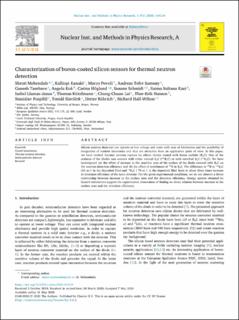Characterization of boron-coated silicon sensors for thermal neutron detection
Mehendale, Shruti Vineet; Kanaki, Kalliopi; Povoli, Marco; Samnøy, Andreas Tefre; Tambave, Ganesh Jagannath; Kok, Angela; Höglund, Carina; Schmidt, Susann; Kazi, Saima Sultana; Llamas-Jansa, Isabel; Kittelmann, Thomas; Lai, Chung-Chuan; Hansen, Thor-Erik; Pospisil, S.; Slavíček, Tomáš; Røhrich, Dieter; Hall-Wilton, Richard
Journal article, Peer reviewed
Published version

Åpne
Permanent lenke
https://hdl.handle.net/11250/2755438Utgivelsesdato
2020Metadata
Vis full innførselSamlinger
Originalversjon
Nuclear Instruments and Methods in Physics Research Section A : Accelerators, Spectrometers, Detectors and Associated Equipment. 2020, 972, 164124 10.1016/j.nima.2020.164124Sammendrag
Silicon neutron detectors can operate at low voltage and come with ease of fabrication and the possibility of integration of readout electronics and thus are attractive from an application point of view. In this paper, we have studied thermal neutron capture by silicon diodes coated with boron carbide (B4C). One of the surfaces of the diodes was covered with either natural B4C (𝑛𝑎𝑡B4C) or with enriched B4C (𝑒𝑛B4C). We have investigated: (a) the effect of increase in the sensitive area of the surface of the diode covered with B4C on the neutron detection efficiency and (b) the effect of enrichment of 10B in B4C. The difference in 10B in 𝑛𝑎𝑡B4C (16 at.% in the deposited film) and 𝑒𝑛B4C ( 79 at.% in the deposited film) leads to about three times increase in detection efficiency of the same detector. For the given experimental conditions, we do not observe a direct relationship between increase in the surface area and the detection efficiency. Energy spectra obtained by Geant4 simulations support the experimental observation of finding no direct relation between increase in the surface area and the detection efficiency.
